Ecosystem @ Wellington
An ecosystem is a community of living organisms together with the non-living components of their environment such as air quality, amount of light, water and mineral soil, interacting as a system.
The Ecosystem at Wellington Primary can be primarily divided into the Pond and Garden ecosystem.
Pond Ecosystem@Wellington

A pond, a large earth depression where water collects, often has a shallow depth composition to it. The ponds shallowness allows sunlight to penetrate to the bottom, which allows underwater plants to grow. Pond plants either grow entirely underwater or partially above the surface or float on the surface. A minority of plants will also grow along the pond’s edge. The pond in our compound is not a natural one but made from cement. Potted partially submerged plants have been used for many years now and a lot of soil has been deposited on the floor of our pond enabling it support partially submerged plants such as cattail and water lily. Ponds will support a large variety of animal and plant life, such as birds, small fish, bacteria, algae, and lily pads. Ponds usually regulate the same water temperature ranging from the water’s surface to the bottom.
Located next to our ecopond, is our Koi Pond which has a mini waterfall flowing down from about two metres above the pond. Having a waterfall like this in our pond not only creates a better environment for our fish but the therapeutic benefits for us are also amazing. The soothing sounds of our garden waterfall rushing over the rocks will bring us back to nature.
Another benefit of having a waterfall is that they increase water molecules and bring more oxygen to the pond water, creating an ideal habitat for our Japanese Koi fish. Stepped falls have more surface area and turbulence than straight falls. This increases the air and water interaction that allows oxygen to be dissolved, creating natural oxygenators for the pond.
A pond ecosystem refers to a community of freshwater organisms largely dependent on each of the surviving species to maintain a life cycle. Our pond’s shallow water body barely reach one metre in depth and allow the sun to penetrate to its bottom, allowing freshwater plants to grow. The pond ecosystem at Wellington consists of algae, microorganisms such as bacteria, plants namely floating, partially submerged and underwater, various fish, frogs, insects such as dragonflies, turtles and even birds, which come to quench their thirst.

All the organisms fall into three distinct classifications namely, producers, consumers, and decomposer. The pond’s natural cycle begins with the producers and then to the consumers before ending with the decomposers.
A pond’s ecosystem consists of abiotic environmental factors and biotic communities of organisms. Abiotic environmental factors of a pond’s ecosystem include temperature, flow, and salinity. The percentage of dissolved oxygen levels in a water body determines what kind of organisms will grow there. An aquarium water pump is used in our pond to supply oxygen for the living things in the ecosystem. After all, fish need dissolved oxygen in order to survive. However, anaerobic bacteria will not thrive in an ecosystem pumped with dissolved oxygen. A water body’s salinity (amount of salts in the water) may also determine the different species present. For instance, marine organisms tolerate salinity, while freshwater organisms will not thrive when exposed to salt. Our pond should have a salinity level of almost zero as the water collected in the pond is either rainwater or freshwater from our taps.
A pond ecosystem consists of four habitats, including the shore, surface film, open water, and bottom water. The shore, depending on its rocky, sandy, or muddy composition, lures in various organisms. The shores of the pond here are mainly rocky shores may not allow plants to grow, while muddy or sandy shores attract grasses, algae, earthworms, snails, protozoa, insects, small fish, and microorganisms. The pond’s surface breeds excellent ground for water striders, marsh traders, free-floating organisms, and organisms that can walk on the surface of water, although, it is quite rare to see them in our pond. An open-water habitat permits sizable fish, plankton, phytoplankton, and zooplankton to grow. Phytoplankton includes a large variety of algae, while zooplankton refers to insect larvae and invertebrates. Fish feed on plankton, or tiny organisms. The bottom-water habitat varies depending upon the pond’s depth. Shallow ponds with sandy bottoms provide a nesting environment for earthworms, snails, and insects. Deep-ended ponds have muddy bottoms, which allow various microorganisms, such as flatworms, rat-tailed maggots, and dragonfly nymphs to reproduce and survive.
A pond’s ecosystem food chain also has three basic trophic levels. The first trophic level represents the producer and autotrophs, such as phytoplankton and plants. Producers prepare their own food with the energy emitted from the sun through a process known as photosynthesis. The second trophic level consists of herbivores, such as insects, crustaceans, and invertebrates that inhabit the pond and consume the plants. The third trophic level comprises of carnivores, such as various sizes of fish, which feed on both the plants and herbivores on top of the first and second trophic levels. Saprotrophic organisms, also known as decomposers located on the bottom of the food chain, help decompose dead organic matter, which further breaks down into carbon dioxide and essential nutrients, such as nitrogen, phosphorus, and magnesium. These nutrients supply the necessary life force for the first trophic level organisms to produce food for the second trophic organisms, which results in the perpetual flow of energy in the pond’s ecosystem.
Garden Ecosystem@Wellington
All organisms are affected by its immediate surroundings or environment. The environment of an organism is made up of all the factors which affect its growth, development and survival.
The environment may be divided into the biotic and abiotic environments. The biotic environment is made up of biotic factors, that is, all the living things in the environment. The abiotic environment is made up of all the physical factors that affect the organism. These include the air, temperature and amount of water and light in the environment.
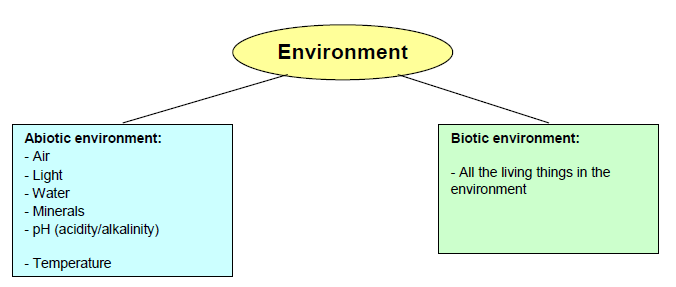
The environment of our school’s gardens and mini-gardens is an example of a local environment. The abiotic environment of the eco-garden is determined by various physical factors such as air, water, light and temperature. Some of these factors change with the time of the day and year. The eco-garden receives more light during the day than at night. The amount of rain the eco-garden receives will vary according to the seasonal changes in the wind directions. Physical conditions may vary in the different locations of the eco-garden. For example, the open areas near our entrance of school and near the carpark receive more sunlight than the shady areas at our community and lush gardens and in our vertical green walls.
Soil is also part of the abiotic environment of the eco-garden. Soil factors include soil type, temperature, pH and the air, water, mineral and organic (humus) contents of the soil. There are different types of soil. Clay is mainly made up of very fine particles of mostly hydrated aluminium silicates, while sand is mainly made up of larger particles of silicon dioxide. The particle size and chemical composition of the soil affect the types of plants growing in it and the animals living in it.
The biotic environment of the eco-garden is made up of organisms living in the eco-garden. These include plants, animals, fungi and micro-organisms such as bacteria. The common land plants which can be found in our eco-gardens and indoor gardens is shown in the table below:
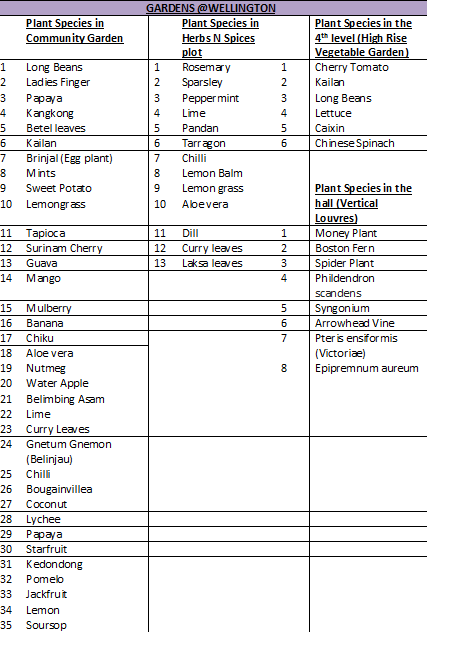
The table below shows some examples of animals commonly found in our eco-garden during the day.
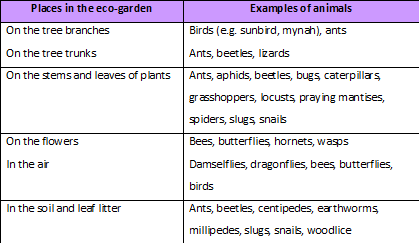
The following are areas in the school which have been aesthetically developed to give it the luscious greenery which provides the habitats for the animals above:
COMMUNITY GARDEN
Our Community Garden is a continuous programme to engage and educate children on the importance of caring for community and biodiversity. Residents, parents, staff and students have begun the planting of vegetables and fruit trees in the enclosed school compound that has been isolated from the main school building for sharing as a common free-access community area through a biometrically controlled gate creating the opportunity to care for the community, and bond together with a ‘kampong-like spirit’. Members of the school are now working more closely with residents interested in kampong farming right at their door step. Through this initiative, a mutual understanding and bonding will develop between the residents and the members of the school and our students are beginning to realise the benefit through their involvement in caring for flora and environment.
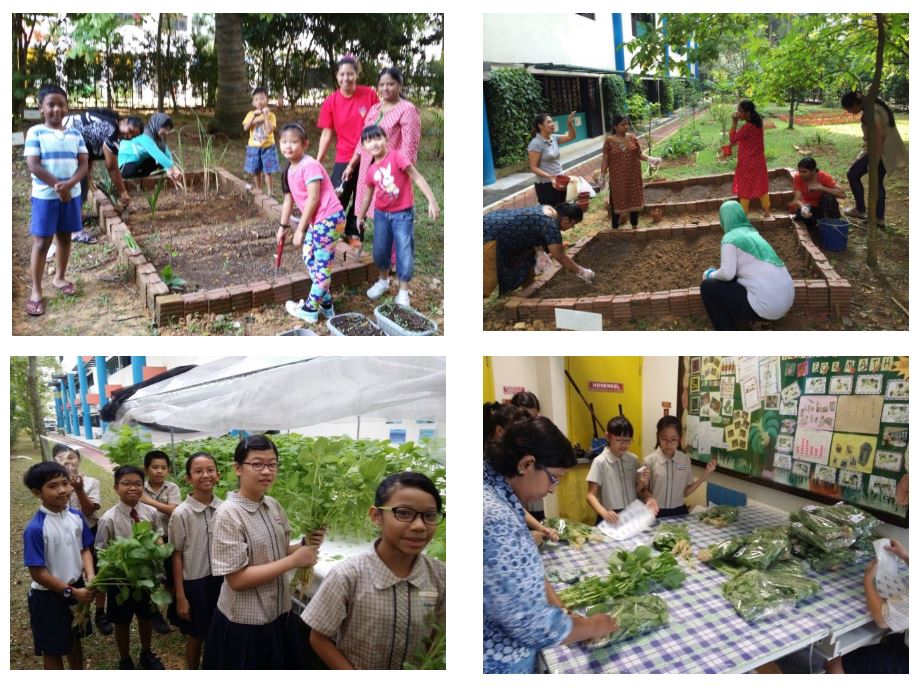
HIGH-RISE VEGETABLE FARMING
The development of the high-rise vegetable farming project on the 4th level is designed to help our science teachers provide our students with meaningful hands-on, outdoor education whereby the students are involved in investigating scientific problems in subjects such as plant growth requirements, land use, nutrition, food systems, origins and medicinal value. The programme aims to empower every student to take ownership of their own learning when are they are involved in active project-based group research and presentations.
The project will provide endless opportunities for experiential and discovery learning where our pupils can see, feel, touch and smell the plants around them. By creating a meaningful and fun learning experience, we hope that the pupils would have had an impactful learning.
Ultimately, students will understand the overall aesthetic and physical benefits of having plants all around us, especially in a land-scarce country like ours.
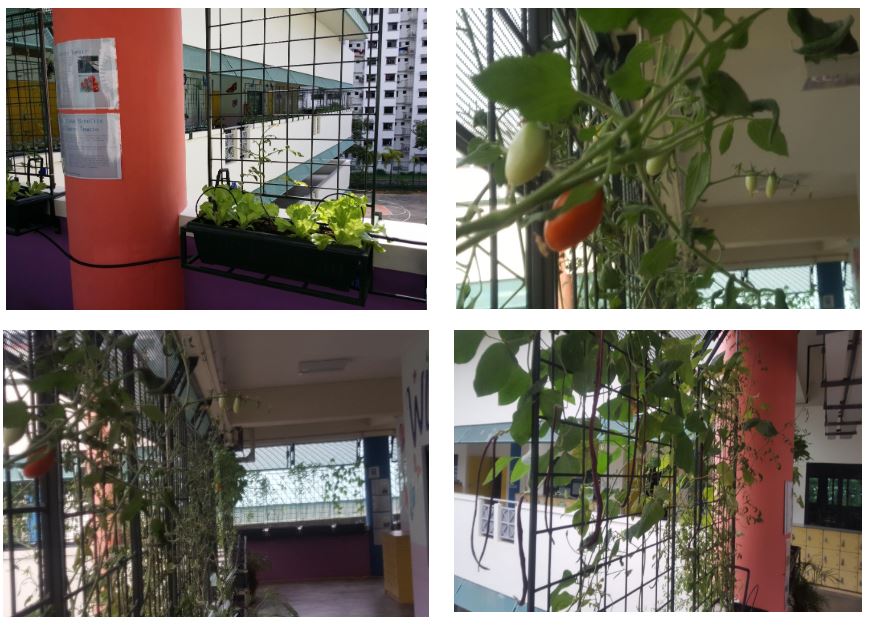
LUSH GARDENS (HERBS AND SPICES)
A Spices and Herbs garden known as the LUSH (Learning using Spices and Herbs) garden was created last year by the science teachers. Pupils explored the garden for their “out of classroom learning” and had to source for the available herbs and spices that are planted around the school and transplanted them into the garden. As such, the pupils had to go online to research what are herbs and spices and then source and identify them in our schools.
Pupils have to research on the conditions needed for the herbs and spices to grow and if they will need direct sunlight. They will then decide on the location to plant the herbs and spices in the garden (receive maximum sunlight/ minimum sunlight). This encourages them to be more green and sensitive to the needs of the plants.
As for the aesthetic portion of the garden, pupils are not allowed to buy any new materials. They are encouraged to source around the school for materials to decorate the garden. As such, this teaches the pupils to be less wasteful and to reuse the available materials in our school.
The pupils found an old fountain that is not used and some old boulders and used them to decorate the garden. They also made use of pebbles available in the school to line the walkways to make the borders more visible and outstanding.
This programme (8 months) not only teaches the children to be green and understand more about the plants, it also leads them to innovate and create ideas when no fund is available to them for the decoration of the garden.
‘Egg’cellent PET Vegetables Garden
This is a “student-teacher’-made green habitat whereby PET bottles are innovatively reused to create a hanging garden. By maintaining the plants, students found out that egg shells make good fertilisers which release calcium and other minerals into the soil. The teachers encouraged the students to read up more on plant fertilisation. Some students found out that diluted milk can provide fertilisers faster to the plants as egg shells may take a longer time to decompose. Their first experiment involved the planting of lettuce and it turned out to be a great success. Through this project, the students not only understood the importance of reusing and recycling, they also learnt an interesting science fact on plant fertilisation and demonstrated to all that a beautiful hanging garden can be created using recycled materials if we use our imagination.
CONCLUSION
Through this wonderful ecosystem that exists in Wellington, we, the staff and students at Wellington Primary School are able to experience the colours, the shapes and the smell of flora and fauna in an ecosystem that we helped to create and evolve on its own. Information posters, name placards of plants and information on notice boards provide the students and visitors to the school with information about plants that are grown here. The ultimate goal is to help children and adults get closer to nature, making them realize that humans, plants and animals can live all together in harmony, without damaging each other, thus understanding the important message of going green.
References
1) http://www.thewaterpage.com/pond-ecosystem.htm
2) https://en.wikipedia.org/wiki/Ecosystem
3) A Guide to the Botanic Gardens Jungle (Publisher: Singapore Science Centre)
4) A Guide to the Bukit Timah Nature Reserve (Publisher: Singapore Science Centre)
5) A Guide to the Freshwater Life in Singapore (Publisher: Singapore Science Centre)
6) A Guide to Pond Life (Publisher: Singapore Science Centre)
Written by Mr Sivasegaran, School Staff Developer

